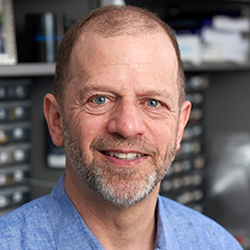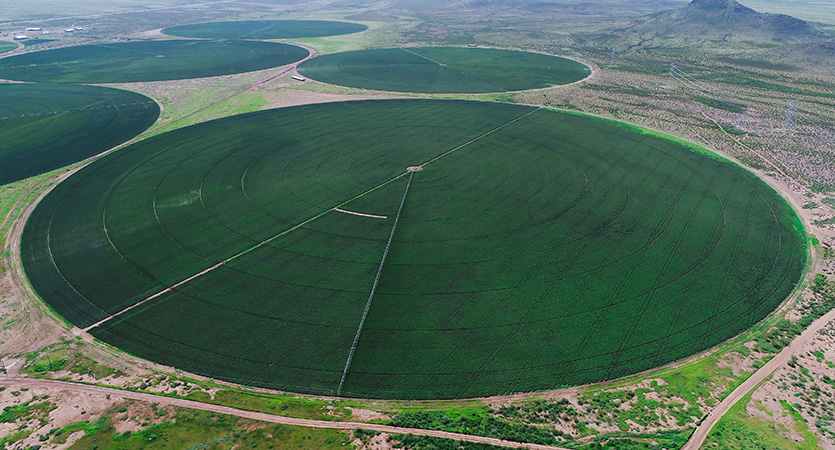How a McCormick Student Wants to Help Feed the World
Senior Shane Dolan has developed a prototype device to help farmers more efficiently use water

One of the great challenges of the 21st century will be food supply. Based on the United Nations’ projected global population growth, the amount of food available to adequately feed the world’s people must increase by 25-70 percent by 2050.
This massive growth presents significant obstacles. One will be the stress placed on agriculture and resulting impacts on the environment and natural resources. Already, agriculture contributes to around 15 percent of anthropogenic greenhouse gas emissions, which figures to rise as more is demanded of farmers.
A Northwestern Engineering student is trying to help.
For his mechanical engineering independent study project, senior Shane Dolan (’22) has designed and built OptiAg, an Internet of Things-enabled intelligent sprinkler controller for large agricultural operations. Using satellite imagery and sensor data, the system evaluates the health of the crops in a field. Based on that information, it breaks down a field into small zones and dictates which ones need the most water.

The special nozzles Dolan developed allow water to be precisely applied only where it is needed.
After working for the last two quarters, Dolan built a software model and prototype and found potential water savings around 10-13 percent for some crops, which translates to nearly $130 per acre in savings for each year in the test cases he ran. Cumulated across a standard square-mile field, farmers could see savings on the order of $65,000 per year.
“This allows for an optimal amount of water to be used, avoiding resource waste and cost associated with overwatering,” Dolan said. “The design I came up with is retrofittable and farmers can easily upgrade their existing systems to harness the resource savings without significant changes to their existing equipment or large cost barriers.”
Rural inspiration
The idea, though, didn’t come out of nowhere.
Dolan grew up in suburban Oklahoma City and was exposed to agriculture at a young age. He has relatives who are farmers, and Dolan saw their challenges firsthand.
After his first year at Northwestern, Dolan worked at a small agriculture startup called MADTECH Modern Agronomy, a company that used fixed-wing drones to map fields to allow farmers to see what their crops looked like from the sky in real-time. Dolan improved that idea by combining it with his McCormick School of Engineering education to use satellite imagery to detect photosynthesis. Dolan’s prototype models crop health and acts on it by combining mapping analysis with an on-the-ground hardware solution to significantly benefit farmers.
The idea first went into motion during Dolan’s second year at Northwestern Engineering when he began exploring the code to download satellite imagery and figured out how to translate that into crop data. But due to school commitments, Dolan didn’t have time to flesh it out until his fourth year, when he asked Professor Michael Peshkin to allow him to pursue it for his independent study project.
Dolan’s proposal went above and beyond.

“It was really thorough, and he came in already knowing the market,” said Peshkin, Breed Senior Professor of Design and professor of mechanical engineering. “Due to his agricultural experience, Shane had investigated this area quite a bit.”
The software was the first task Dolan tackled. He grabbed code that could download imagery from NASA satellites and was able to process that information into digital maps. Those maps could then output sets of instructions for the valves.
In his study of prior art, Dolan discovered there were some similar solutions on the market. The big brands in the center-pivot market only sell variable-rate irrigation systems with new systems and expensive annual subscriptions. The competitors’ hardware requires significant investment, which is unattainable for many. Low-cost hardware, retrofittable functionality, and universality drive down the investment for Dolan’s design allow farmers to realize higher rates of return.
Dolan’s valves are designed to be a retrofit for existing center pivot irrigators, which have hundreds of sprinkler heads over up to a half-mile of arm length. His intelligent sprinkler heads are screw-in replacements for existing sprinkler heads. Dolan prototyped them with off-the-shelf sprinkler components and WiFi-enabled computational boards.

Dolan built them on a breadboard and tested the code he wrote, before further refining the package into a housing that could be placed on a piece of equipment. Dolan identified a diverse set of design requirements to handle the harsh environmental conditions seen in agriculture. His valves need to receive instructions and operate reliably in challenging climates all around the world. Some later prototypes he built were tested in extreme temperatures and weather conditions.
As of now, the hand-held hardware is fully developed. The next step is to find someone to let Dolan try out his device.
Technology for 21st century challenges
The potential benefits of OptiAg are clear.
Beyond just helping farmers grow food, the system could address the water shortages which figure to be a problem as the planet strains to nourish more and more people. When water isn’t used efficiently, it causes cost overruns. Wasted water also causes droughts and shortfalls.
My role was to let Shane be Shane and see if I could give him a little helpful guidance on intellectual property and maybe some technological pointers and poke at his tech plans a little bit. But he was pretty solid. Breed Senior Professor of Design and Professor of Mechanical Engineering
During this process, Peshkin has helped Dolan with the electronic design and circuitry, and raised questions that Dolan might not have thought about.
That said, it’s not like Dolan has needed much help.
“My role was to let Shane be Shane and see if I could give him a little helpful guidance on intellectual property and maybe some technological pointers and poke at his tech plans a little bit,” Peshkin said. “But he was pretty solid.”
Dolan has been an intern at Tesla for over a year, working as a technical program manager of battery design and will work there full-time following graduation. Eventually, however, he hopes to turn this project into his career.
“It’s a super-cool problem to solve,” Dolan said. “It’s meaningful to me.”



